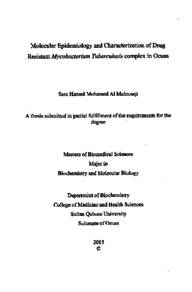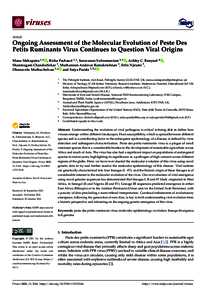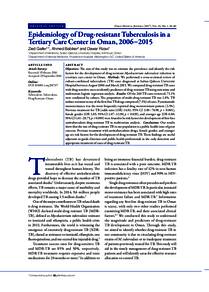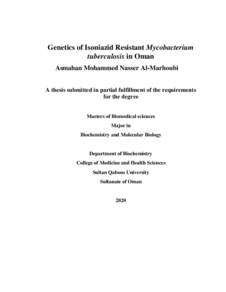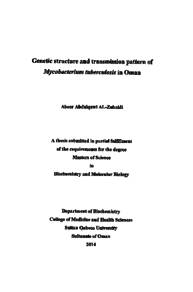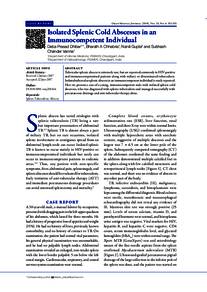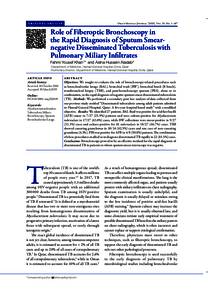Document
Molecular epidemiology and characterization of drug resistant mycobacterium tuberculosis complex in Oman.
Publisher
Sultan Qaboos University
Gregorian
2015
Language
English
English abstract
Tuberculosis is a fatal contagious disease caused by Mycobacterium tuberculosis complex (MTBC) resulting in the death of 2 million people worldwide every year. The disease is treatable; however, the emergence of resistant strains to anti-tuberculosis drugs is a major concern. This study examined the distribution of drug resistant tuberculosis in Oman and used spoligotyping to identify the extent of genetic diversity and clustering of MTBC isolates among Omanis and expatriates.
The study examined a total of 748 MTBC isolates collected between 2008 and 2013 in the Central Public Health Laboratories in Oman. The in vitro drug response of these isolates was determined by Drug Susceptibility Testing (DST), the spoligotypes were defined based on amplification of direct repeat (DR) region, while polymerase chain reaction (PCR) and DNA sequencing were used for the detection of mutations associated with resistance to anti-tuberculosis drugs. Chi-square test was performed to evaluate the association between the drug resistance mutations and DST results.
The study showed that CAS and EAI clades were the predominant spoligo patterns in Oman among both Omanis and expatriates. Out of 548 isolates examined by spoligotyping, 67.3% were in clusters. The clusters ranged from 2 to 68 isolates with clustering rate of 41.0%. Clustered MTB isolates among both Omanis and expatriates shared 23 different sub-lineages. Clustering of TB among both Omanis and expatriates suggests ongoing transmission between the two groups, which needs further evaluation. High prevalence of drug resistant strains existed in Oman, out of 693 of examined isolates 33.3% were found to be isoniazid resistant (INH 21.0% were streptomycin resistant (SM) and 17.3% were pyrazinamide resistant (PZ ). 60.3% of the INH MTB isolates carried katG $315T mutation and 23.5% carried the inh -15CT mutation. Similarly, 95% of the RIF MTB strains harbored mutated rpoB gene, out of these 70.0%, 20.0% and 5.0% carried S531L, H526L and D516V, respectively. MDR-TB, defined as strains resistant to at least INH and RIF, represented 2.4% of the exaimned MTB isolates. CA$1_Delhi and Beijing family predominated among MDR strains. Analysis of 12-MIRU-VNTR of the MDR-MTBC isolates indicated that each patient was infected with a unique strain, most likely, as a result of reactivated latent infection acquired earlier.
This study represents a baseline study of the MTBC population structure in Oman, and may serve as a motivation for future molecular epidemiological studies in the region, and help comprehend the global tubercle bacilli genotypic dive is caused by a wide diversity of spoligotypes with predominance of two genotype lineages originate from the Indian subcontinent (CAS & EAI) highlighting the role of expatriates in disseminating the disease. This hypothesis is supported by the high rate of shared clusters of spoligotypes among Omanis and expatriates. Treatment guidelines should consider the widespread of MTB strains carrying drug resistance mutations. This study also gave an insight into the MTBC genetic biodiversity in Oman, the predominant spoligotypes and mutations associated with resistance to anti-TB drugs.
Member of
Resource URL
Arabic abstract
السل هو مرض معدي فتاك يسببه المتفطرة السلية (MTBC ) مما أدى إلى وفاة ۲ مليون شخص سنويا. هذا المرض قابل للعلاج ولكن ظهور سلالات مقاومة للعقاقير المضادة للسل هو مصدر قلق كبير. هدفت هذه الدراسة إلى تحديد معدل انتشار السيل المقاومة للأدوية في سلطنة عمان و استخدمت عديدات النكليوتيد البينية لتحديد مدى التنوع الوراثي و دراسة أنواع المتفطرة السلية المشتركة بين العمانيين والوافدين . شملت هذه الدراسة ۷۶۸ مستفردة للمتفطرات السلبية الرئوية التي تم جمعها بين عامي ۲۰۰۸ و ۲۰۱۳ في مختبرات الصحة العامة المركزية في سلطنة عمان . تم تقييم مدى قابلية المتفطرة السلية الرئوية المضادات الحيوية باستخدام اختبار الحساسية للعقاقير(DST)، وتم أيضا تحديد أنماط عديدات النكليوتيد البينية للمتفطرات السلية بناء على تضخيم منطقة التكرار المباشر (DR )، في حين استخدمت تفاعل البلمرة التسلسلي ( PCR) و تحليل متتاليات الحمض النووي للكشف عن الطفرات المرتبطة بمقاومة المضادات الحيوية للسل الرئوي . تم إجراء اختبار مربع كاي لتقييم العلاقة بين الطفرات المقاومة للأدوية ونتائج اختبار الحساسية للعقاقير. أظهرت الدراسة أن CAS و EAI من الفصائل السائدة لأنماط عديدات النكليوتيد البينية في سلطنة عمان بين كل من العمانيين والوافدين .من 54۸ مستفردة للمتفطرات السلية الرئوية التي تم فحصها بعديدات النكليوتيد البينية ، ۱۷ . ۳ % كانت في مجموعات وتراوحت أعداد المستفردات في كل مجموعة بين ۲ الی ۹۸ مع معدل تجميع 41 . 0 % . وقد تم رصد ۲۲ نمط مشترك بين العمانيين والوافدين. وجود مجموعات مشتركة بين كل من العمانيين والوافدين يوحي إلى انتقال مستمر بين الجماعتين ، والتي تحتاج إلى مزيد من التقييم. توضح النتائج وجود ارتفاع في معدل انتشار السلالات المقاومة للمضاد الحيوي في سلطنة عمان فمن أصل ۹۹۳ من المستفردات التي تم فحصها ۳۳ . ۳ ٪ وجدت لتكون مقاومة للإيزونيازيد (*INH) ، 21 . 0 ٪ مقاومة لستربتومايسين (SM8) و ۱۷ . ۳ ٪ كانت مقاومة البيرازيناميد (PZAR ). ۹۰ . ۳ ٪ من المستفردات المقاومة للإيزونیازید حملت الطفرة katGS315T وه.۲۳ ٪ حملت الطفرة inhA - 15CT . وبالمثل، ۹۰ ٪ من المستفردات المقاومة للريفامبيسين لديها تحور في جين rpoB، من ضمن هذه المتفردات ۷۰ . ۰ ۲۰ . ۰ ، و ۰ . ۰ ٪ حملت الطفرات التالية FI526L S531L و D516V ، على التوالي. مستفردات المتفطرة السلية متعددة المقاومة للمضاد الحيوي ( MDR - MTB ) ، المعرفة بالسلالات المقاومة على الأقل ل INH و RIF ، تمثل ۲ . 4 ٪ من العزلات المدروسة. CAS1 Delhi وبكين من الأنماط الأكثر شيوعا بين سلالات MDR. تحلیل ۱۲ MIRU - VNTR لمستفردات المتفطرة السلية متعددة المقاومة المضاد الحيوي ( MDR - MTB ) أشارت إلى أن كل مريض كان مصابا بسلالة فريدة من نوعها، على الأرجح، نتيجة تنشيط العدوى الكامنة المكتسبة في وقت سابق وتمثل هذه الدراسة دراسة أساسية للتركيبة السكانية ل MTBC في سلطنة عمان ، ويمكن أن تكون بمثابة الدافع الدراسات الوبائية الجزيئية المستقبلية في المنطقة ، وتساعد على فهم التنوع الوراثي العالمي لمستفردات المتفطرة السلية. المستفردات المسببة للسل الرئوي في سلطنة عمان هي من مجموعة متنوعة واسعة أنماط عديدات النكليوتيد البينية مع غلبة اثنين ذات أصول تنشأ من شبه القارة الهندية (CAS و EAI ) مما يدل على دور ال المرض. ويدعم هذه الفرضية ارتفاع عدد المجموعات المشتركة من أنماط عديدات النكليوتيد البينية بين العمانيين والوافدين . يجب اعادة النظر في المبادئ التوجيهية للعلاج مع الانتشار الواسع لسلالات MTB التي تحمل الطفرات المقاومة للأدوية . كما قدمت هذه الدراسة نظرة ثاقبة في التنوع البيولوجي الوراثي ل MTBC في سلطنة عمان ، و أنماط عديدات النكليوتيد البينية الغالبة والطفرات المرتبطة بمقاومة الأدوية المضادة للسل الرئوي.
Category
Theses and Dissertations

